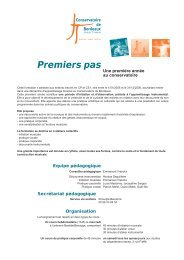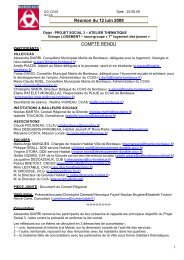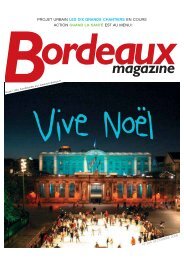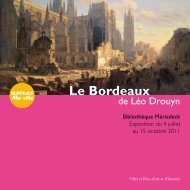Carlo Scarpa, Tobia Scarpa : Dialogo sospeso au ... - Bordeaux
Carlo Scarpa, Tobia Scarpa : Dialogo sospeso au ... - Bordeaux
Carlo Scarpa, Tobia Scarpa : Dialogo sospeso au ... - Bordeaux
Create successful ePaper yourself
Turn your PDF publications into a flip-book with our unique Google optimized e-Paper software.
9Since 2003, the Museum of Decorative Arts of Borde<strong>au</strong>x organizesregularly exhibitions of design. This year, the museum presents thework of the venetian architect <strong>Tobia</strong> <strong>Scarpa</strong> and the work of his father,<strong>Carlo</strong>, who died in 1978 and with whom he was first an apprendice, thena business partner. <strong>Tobia</strong> took an active role in the organization of thisexhibition which gathers, for the first time, the work of both creators.<strong>Carlo</strong> <strong>Scarpa</strong> (1906 Venice–1978 Sendai, Japan)More than thirty years after his death, <strong>Carlo</strong> <strong>Scarpa</strong> (1906 Venice–1978Sendai, Japan) is still considered one of Italy’s more important architects.During his long career from the 20’s until the 70’s, most of his work is settledin Venetia. His name is renown due to the rest<strong>au</strong>rations of historical buidingssuch as the Correr museum, the Castelvecchio museum, and the Querinifondation among others.<strong>Carlo</strong> <strong>Scarpa</strong> spent much of his early childhood in Vicenza wherehis family relocated when he was two years old. After his mother'sdeath, when he was thirteen, the family moved back to Venice. <strong>Carlo</strong>attended the Academy of Fine Arts where he focused on architecturalstudies with the architect Francesco Rinaldo. <strong>Scarpa</strong> married Rinaldo'sniece, Onorina Lazzari. Graduated from the Accademia, he became aprofessor of Architecture. <strong>Scarpa</strong> t<strong>au</strong>ght drawing and interior decorationat the Istituto universitario di architettura di Venezia from the late 1940s.Simultaneously he began to collaborate to Venini glass factory of Murano.His architecture is deeply sensitive to the history of the buildings and thecities; he was also a great observer of the changes of seasons. Althoughmost of his built work is located in the Veneto region, he also made projectsfor other regions of Italy as well as foreign countries.One of his last projects, left incomplete at the time of his death, wascompleted in 2006 by his son <strong>Tobia</strong>: the Villa Palazzetto in Monselice.Besides the mentioned projects, <strong>Scarpa</strong>’s most significant works are theGipsoteca Canoviana at the Canova Museum in Possagno (1955-1957), theCastelvecchio museum in Verona (1954-1956), and the Fondazione QueriniStampalia, Venice (1961-1963) where his great awareness of the city’shistory provides a new dimension. One of the most ambitious landscape andgarden projects of his career is the Brion Sanctuary at San Vito d’Altivole inVeneto, realized between 1969 and 1978.Other works that cannot go unnoticed are the Venice Biennale Pavilions, andseveral refurbishing and extensions of Venice museums such as Correr andAccademia museums, and the refurbishing of private places such as CasaVeritti, Udine, Casa Balboni, Venice, Casa Ottolenghi, Verona.After his death in 1978 in Sendai, Japan, <strong>Carlo</strong> <strong>Scarpa</strong> was buried in Brionfamily cemetery. In 1984, the Italian composer Luigi Nono dedicated him thecomposition A <strong>Carlo</strong> <strong>Scarpa</strong>, Architetto, Ai suoi infiniti possibili.
















